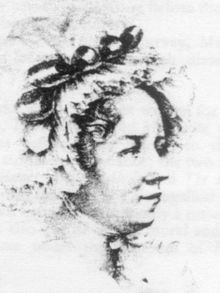
Back ماري مارثا شيروود Arabic ماری مارثا شیروود AZB Mary Martha Sherwood Spanish مری مارتا شروود Persian Mary Martha Sherwood Finnish Mary Martha Sherwood French Mary Martha Sherwood Portuguese Шервуд, Мэри Марта Russian Мери Марта Шервуд Serbian Mary Martha Sherwood Swedish
Mary Martha Sherwood | |
|---|---|
 | |
| Born | Mary Martha Butt 6 May 1775 Stanford-on-Teme, Worcestershire, England |
| Died | 22 October 1851 (aged 76) Twickenham, London, England |
| Occupation | Writer (novelist) |
| Period | 1814–1848 |
| Genre | Children's literature |
Mary Martha Sherwood (née Butt; 6 May 1775 – 22 September 1851) was a nineteenth-century English children's writer. Of her more than four hundred works, the best known include The History of Little Henry and his Bearer (1814) and the two series The History of Henry Milner (1822–1837) and The History of the Fairchild Family (1818–1847). Her evangelicalism permeated her early writings, but later works cover common Victorian themes such as domesticity.
Mary Martha Butt married Captain Henry Sherwood and moved to India for eleven years. She converted to evangelical Christianity, opened schools for the children of army officers and local Indian children, adopted neglected or orphaned children, and founded an orphanage. She was inspired to write fiction for the children in the military encampments. Her work was well received in Britain, where the Sherwoods returned in 1816 for medical reasons. She opened a boarding school, edited a children's magazine, and published hundreds of tracts, novels, and other works for children and the poor, which increased her popularity in both the United States and Britain. She died in 1851 in Twickenham, Middlesex.
Sherwood's career included three periods: her romantic period (1795–1805), her evangelical period (1810 – c. 1830), in which she produced her most popular and influential works, and her post-evangelical period (c. 1830–1851). Themes in her writing included "her conviction of inherent human corruption", her belief that literature "had a catechetical utility" for every rank of society, her belief that "the dynamics of family life" should reflect central Christian principles, and her "virulent" anti-Catholicism.[1] Sherwood was called "one of the most significant authors of children's literature of the nineteenth century".[2] Her depictions of domesticity and ties with India may have influenced many young readers,[3] but her work fell from favour as children's literature broadened in the late nineteenth century.